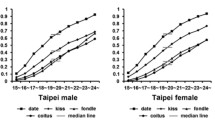Abstract
The national teen birth rate is higher in rural compared to urban areas. While national data suggest rural areas may present higher risk for adverse sexual health outcomes among adolescents, it is unknown whether there are differences within the state of Florida. Overall, Florida has poorer sexual health indicators for adolescents compared to national rates. The purpose of this study was to assess differences in sexual behaviors among Florida adolescents by rural–urban community location. This study includes baseline data from a randomized controlled trial conducted in Florida high schools. Of the 6316 participants, 74% were urban and 26% were rural. Participants responded to questions on sexual behaviors, sexual behavior intentions, and demographics. We estimated the effect of rural–urban status on risk outcomes after controlling for demographic variables using generalized linear mixed models. More teens from rural areas reported ever having sex (24.0%) compared to urban teens (19.7%). No significant differences were observed for most of sexual behaviors assessed. Nonetheless, urban participants were less likely to intend to have sex without a condom in the next year compared to rural participants (aOR = 0.76, 95% CI 0.63–0.92). Overall, there were no major differences in sexual behaviors between rural and urban adolescents in Florida. However, sexual intentions differed between rural and urban adolescents; specifically, rural adolescents were more likely to intend to have sex without a condom in the next year compared to urban adolescents. Understanding the specific disparities can inform contraception and sexual health interventions among rural youth.
Similar content being viewed by others
References
Curtis, A. C., Waters, C. M., & Brindis, C. (2011). Rural adolescent health: The importance of prevention services in the rural community. The Journal of Rural Health: Official Journal of the American Rural Health Association and the National Rural Health Care Association, 27(1), 60–71.
Maness, S. B., & Branscum, P. (2017). Utilizing a social determinant of health framework as determinants of perceived behavioral control. Family & Community Health, 40(1), 39–42.
Atav, S., & Spencer, G. A. (2002). Health risk behaviors among adolescents attending rural, suburban, and urban schools: A comparative study. Family & Community Health, 25(2), 53–64.
Hamilton, B. E., Martin, J. A., Osterman, M. J., Curtin, S. C., & Matthews, T. J. (2015). Births: Final data for 2014. National Vital Statistics Reports: From the Centers for Disease Control and Prevention, National Center for Health Statistics, National Vital Statistics System, 64(12), 1–64.
Ng, A. S., & Kaye, K. (2015). Sex in the (Non)City: Teen Childbearing in Rural America. Washington, DC: The National Campaign to Prevent Teen and Unplanned Pregnancy.
Finley, C., & Stewart, A. (2013). Working with Rural Teens: Adolescent Reproductive Health in Rural America. Paper presented at the Third Annual Teen Pregnancy Prevention Grantee Conference, National Harbor, MD.
United States Census Bureau. (2014). Florida passes New York to become the nation’s third most populous state, Census Bureau reports Retrieved March 8, 2015, from http://www.census.gov/newsroom/press-releases/2014/cb14-232.html.
Centers for Disease Control and Prevention. (2015). Florida – 2015 State Health Profile Retrieved January 9, 2017, from https://www.cdc.gov/nchhstp/stateprofiles/pdf/florida_profile.pdf.
Kost, K., & Maddow-Zimet, I. (2016). U.S. Teenage Pregnancies, Births and Abortions, 2011: National Trends by Age, Race and Ethnicity Retrieved January 27, 2017, from https://www.guttmacher.org/report/us-teen-pregnancy-trends-2011.
Centers for Disease Control and Prevention. (2016). 1991–2015 High School Youth Risk Behavior Survey Data Retrieved October 21, 2016, from http://nccd.cdc.gov/youthonline/.
Maness, S., Mahony, H., & Buhi, E. R. (2015). How Florida youths measure up to US youths in sexual and reproductive health: Implications for youths across the United States. Vulnerable Children and Youth Studies, 10(1), 26–35.
Walsh-Buhi, E. R., Marhefka, S. L., Wang, W., et al. (2016). The impact of the Teen Outreach Program on sexual intentions and behaviors. Journal of Adolescent Health, 59(3), 283–290.
United States Census Bureau. (2015). Metropolitan and Micropolitan Statistical Areas Main. Retrieved July 27, 2016, from http://www.census.gov/population/metro/.
Lall, R. (2016). How multiple imputation makes a difference. Political Analysis, 24(4), 414–433.
Graham, J. W., Olchowski, A. E., & Gilreath, T. D. (2007). How many imputations are really needed? Some practical clarifications of multiple imputation theory. Prevention Science, 8(3), 206–213.
McCulloch, C. E., Searle, E., & Neuhaus, J. M. (2008). Generalized, Linear, and Mixed Models. Hoboken, NJ: John Wiley & Sons, Inc.
Jones, R. K., & Jerman, J. (2013). How far did US women travel for abortion services in 2008? Journal of Women’s Health, 22(8), 706–713.
Stulberg, D. B., Dude, A. M., Dahlquist, I., & Curlin, F. A. (2011). Abortion provision among practicing obstetrician-gynecologists. Obstetrics and Gynecology, 118(3), 609–614.
Geske, S., Quevillon, R., Struckman-Johnson, C., & Hansen, K. (2016). Comparisons of contraceptive use between rural and urban teens. Journal of Pediatric and Adolescent Gynecology, 29(1), 33–41.
Committee on Adolescent Health Care Long-Acting Reversible Contraception Working Group, The American College of Obstetricians & Gynecologists. (2012). Committee opinion no. 539: adolescents and long-acting reversible contraception: implants and intrauterine devices. Obstetrics and Gynecology, 120(4), 983–988.
Acknowledgements
The authors thank the Florida Department of Health, and the many evaluation data collectors, Teen Outreach Program facilitators, and students who participated in this project.
Funding
This study was funded by the U.S. Office of Adolescent Health (OAH), U.S. Department of Health and Human Services (Grant Number 5 TP1AH000017-01-00). The views expressed in this manuscript are those of the authors and do not necessarily reflect the policies of HHS or the Office of Adolescent Health.
Author information
Authors and Affiliations
Corresponding author
Ethics declarations
Conflict of interest
The authors declare that they have no conflict of interest.
Rights and permissions
About this article
Cite this article
Thompson, E.L., Mahony, H., Noble, C. et al. Rural and Urban Differences in Sexual Behaviors Among Adolescents in Florida. J Community Health 43, 268–272 (2018). https://doi.org/10.1007/s10900-017-0416-6
Published:
Issue Date:
DOI: https://doi.org/10.1007/s10900-017-0416-6



